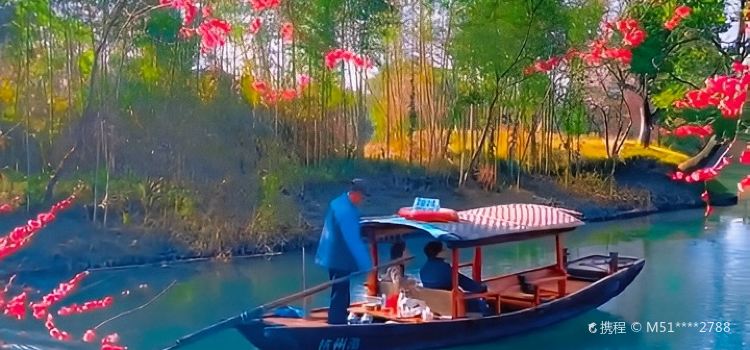江南水乡
No comments yet
Wuhai Airport

0473-6999993
What travelers say:

The food is delicious. The price is cheap. The environment is elegant and beautiful.
More
Reviews of 江南水乡
Some reviews may have been translated by Google Translate
0/5
All (11)
Latest
Photo reviews (6)
The food is delicious. The price is cheap. The environment is elegant and beautiful.
Strolling in Wuhai | Exploring the "Jiangnan Dreamland" of the Northern Frontier Standing by the covered bridge of the Jiangnan Water Village Restaurant, I almost forgot I was in Wuhai, Inner Mongolia. This industrial city, built on coal, hides a charming waterscape of white walls and black tiles, a true "Jiangnan Secret in the Desert." (Insert real-life experience: a surprising discovery while ordering—Mongolian-style roasted whole lamb and West Lake vinegar fish were listed on the menu alongside each other—a wonderful taste encounter!) 🌊The Past and Present of the Water Village The Qianlishan Town, where the restaurant is located, was once a military base for the Shuofang Commandery during the Han Dynasty. Who could have imagined that after two thousand years of wind and sand, this land, once witnessing the "smoke rising from the desert," would blossom into a landscape of "small bridges, flowing water, and homes"? The three artificial lakes draw on the water management wisdom of Suzhou gardens. The weeping willows along the banks are from cuttings taken from West Lake in Hangzhou, and even the bluestone slabs were relocated from ancient Jiangnan towns. (Tip: Visit in the evening, when the setting sun casts its rays across the eaves for the most stunning photos.) 🍲A Gourmet Romance Between Two Cities Chef Lao Zhang is a legend in Wuhai's culinary scene, having spent twenty years training at Louwailou in Hangzhou. His signature hybrid dish—prairie lamb slow-cooked for six hours using the Hangzhou cuisine's "Dongpo Pork" method—delivers a rich yet ungreasy flavor, prompting local diners to exclaim, "This lamb has the soul of Jiangnan." Hidden beneath the grape trellises in the courtyard is a surprise: Wuhai's local Cabernet Sauvignon, aged in Shaoxing rice wine jars. Upon opening the jar, the wine is infused with a subtle sweet osmanthus fragrance. (Must-try seasonal dish: the "Desert Lotus Feast" at the turn of summer and autumn, where all lotus roots are sourced from the restaurant's own greenhouse in the Gobi Desert.) 📍Practical Guide Address: 200 meters west of Qianlishan Town Government, Haibowan District, Wuhai City (free parking available in front). Opening Hours: 10:00 AM - 10:00 PM (reserving a private room near the lake is recommended). In this city surrounded by the Ulan Buh Desert, the Jiangnan Water Village tells the romantic story of "Northern Saijiangnan" with every brick and tile. When camel bells meet oars, when kumis meets Longjing tea, you'll discover that the so-called distant place is just another version of home. #WuhaiTravel #Southern Saijiangnan #New Ways to Eat Mongolian Cuisine #Desert Oasis Check-in #Cross-Regional Cuisine
#Where to go on the weekend Jiangnan is a geographical region in China. The geographical scope of "Jiangnan" varies according to different division standards. Generally speaking, the connotation of Jiangnan's geographical scope should include four aspects: natural geography, administrative geography, economic geography, and cultural geography. The geographical location of Jiangnan determines the climate characteristics of Jiangnan. Jiangnan is adjacent to the east-west Yangtze River in the north, the East China Sea in the east, and the Nanling Mountains in the south. The main climate characteristics of the Jiangnan region are hot, humid, and rainy heat in summer and cold and gloomy and drizzling in winter. Most of the rivers in Jiangnan are the Yangtze River system. There are 132 lakes distributed in Jiangnan, accounting for 63% of the total number of lakes in the country.
In spring, peach blossoms and petals are falling, and willow branches have already sprouted a touch of new green; spring is warm and flowers are blooming, and the soul is warm. The lonely and cold figure before, in the refreshing fragrance of the daughter, the elegant and graceful charm, melts the sorrow in the heart with a clear and peaceful state of mind. Three thousand black hairs are wrapped around the cheeks, the smile is like a flower, and the remaining soft fragrance of the daughter, surrounded by the flower fairy, reflects the tranquility in the starlight, causing the moon to chase! The scenery of Jiangnan is so beautiful, and the scenery has been familiar for a long time. When spring comes, the sun rises from the river, making the flowers on the riverside redder than fire, and the green river water is greener than blue grass. How can people not miss Jiangnan?
Born in an ancient town, I still love to visit it. Strolling in the ancient corridor, listening to grandparents talking about family matters, and feeling the unique style of the old Jiangnan. Surrounded by water, with rivers and ports crisscrossing, green houses, and fishing villages, this is the most original appearance of the Jiangnan water town. The quiet and comfortable environment is worth lingering [Like]